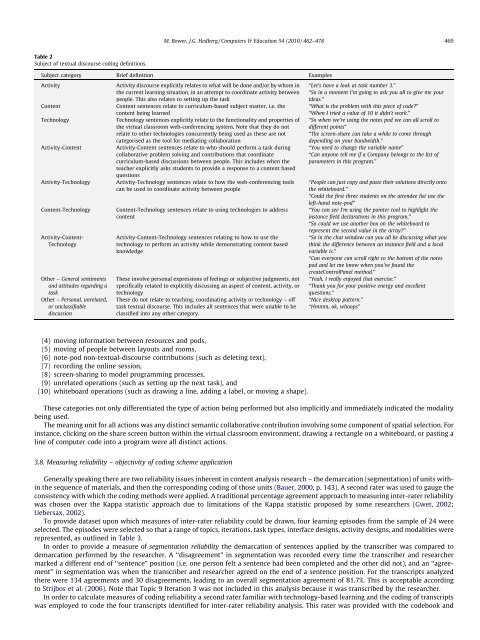A quantitative multimodal discourse analysis of ... - Anitacrawley.net
A quantitative multimodal discourse analysis of ... - Anitacrawley.net
A quantitative multimodal discourse analysis of ... - Anitacrawley.net
You also want an ePaper? Increase the reach of your titles
YUMPU automatically turns print PDFs into web optimized ePapers that Google loves.
M. Bower, J.G. Hedberg / Computers & Education 54 (2010) 462–478 469Table 2Subject <strong>of</strong> textual <strong>discourse</strong> coding definitions.Subject category Brief definition ExamplesActivityContentTechnologyActivity-ContentActivity-TechnologyContent-TechnologyActivity-Content-TechnologyOther – General sentimentsand attitudes regarding ataskOther – Personal, unrelated,or unclassifiablediscussionActivity <strong>discourse</strong> explicitly relates to what will be done and/or by whom inthe current learning situation, in an attempt to coordinate activity betweenpeople. This also relates to setting up the taskContent sentences relate to curriculum-based subject matter, i.e. thecontent being learnedTechnology sentences explicitly relate to the functionality and properties <strong>of</strong>the virtual classroom web-conferencing system. Note that they do notrelate to other technologies concurrently being used as these are notcategorised as the tool for mediating collaborationActivity-Content sentences relate to who should perform a task duringcollaborative problem solving and contributions that coordinatecurriculum-based discussions between people. This includes when theteacher explicitly asks students to provide a response to a content basedquestionsActivity-Technology sentences relate to how the web-conferencing toolscan be used to coordinate activity between peopleContent-Technology sentences relate to using technologies to addresscontentActivity-Content-Technology sentences relating to how to use thetechnology to perform an activity while demonstrating content basedknowledgeThese involve personal expressions <strong>of</strong> feelings or subjective judgments, notspecifically related to explicitly discussing an aspect <strong>of</strong> content, activity, ortechnologyThese do not relate to teaching, coordinating activity or technology – <strong>of</strong>ftask textual <strong>discourse</strong>. This includes all sentences that were unable to beclassified into any other category.‘‘Let’s have a look at task number 3.”‘‘So in a moment I’m going to ask you all to give me yourideas.”‘‘What is the problem with this piece <strong>of</strong> code?”‘‘When I tried a value <strong>of</strong> 10 it didn’t work.”‘‘So when we’re using the notes pod we can all scroll todifferent points”‘‘The screen-share can take a while to come throughdepending on your bandwidth.”‘‘You need to change the variable name”‘‘Can anyone tell me if a Company belongs to the list <strong>of</strong>parameters in this program.”‘‘People can just copy and paste their solutions directly ontothe whiteboard.”‘‘Could the first three students on the attendee list use theleft-hand note-pod”‘‘You can see I’m using the pointer tool to highlight theinstance field declarations in this program.”‘‘So could we use another box on the whiteboard torepresent the second value in the array?”‘‘So in the chat window can you all be discussing what youthink the difference between an instance field and a localvariable is.”‘‘Can everyone can scroll right to the bottom <strong>of</strong> the notespod and let me know when you’ve found thecreateControlPanel method.”‘‘Yeah, I really enjoyed that exercise.”‘‘Thank you for your positive energy and excellentquestions.”‘‘Nice desktop pattern.”‘‘Hmmm, ok, whoops”(4) moving information between resources and pods,(5) moving <strong>of</strong> people between layouts and rooms,(6) note-pod non-textual-<strong>discourse</strong> contributions (such as deleting text),(7) recording the online session,(8) screen-sharing to model programming processes,(9) unrelated operations (such as setting up the next task), and(10) whiteboard operations (such as drawing a line, adding a label, or moving a shape).These categories not only differentiated the type <strong>of</strong> action being performed but also implicitly and immediately indicated the modalitybeing used.The meaning unit for all actions was any distinct semantic collaborative contribution involving some component <strong>of</strong> spatial selection. Forinstance, clicking on the share screen button within the virtual classroom environment, drawing a rectangle on a whiteboard, or pasting aline <strong>of</strong> computer code into a program were all distinct actions.3.8. Measuring reliability – objectivity <strong>of</strong> coding scheme applicationGenerally speaking there are two reliability issues inherent in content <strong>analysis</strong> research – the demarcation (segmentation) <strong>of</strong> units withinthe sequence <strong>of</strong> materials, and then the corresponding coding <strong>of</strong> those units (Bauer, 2000, p. 143). A second rater was used to gauge theconsistency with which the coding methods were applied. A traditional percentage agreement approach to measuring inter-rater reliabilitywas chosen over the Kappa statistic approach due to limitations <strong>of</strong> the Kappa statistic proposed by some researchers (Gwet, 2002;Uebersax, 2002).To provide dataset upon which measures <strong>of</strong> inter-rater reliability could be drawn, four learning episodes from the sample <strong>of</strong> 24 wereselected. The episodes were selected so that a range <strong>of</strong> topics, iterations, task types, interface designs, activity designs, and modalities wererepresented, as outlined in Table 3.In order to provide a measure <strong>of</strong> segmentation reliability the demarcation <strong>of</strong> sentences applied by the transcriber was compared todemarcation performed by the researcher. A ‘‘disagreement” in segmentation was recorded every time the transcriber and researchermarked a different end <strong>of</strong> ‘‘sentence” position (i.e. one person felt a sentence had been completed and the other did not), and an ‘‘agreement”in segmentation was when the transcriber and researcher agreed on the end <strong>of</strong> a sentence position. For the transcripts analyzedthere were 134 agreements and 30 disagreements, leading to an overall segmentation agreement <strong>of</strong> 81.7%. This is acceptable accordingto Strijbos et al. (2006). Note that Topic 9 Iteration 3 was not included in this <strong>analysis</strong> because it was transcribed by the researcher.In order to calculate measures <strong>of</strong> coding reliability a second rater familiar with technology-based learning and the coding <strong>of</strong> transcriptswas employed to code the four transcripts identified for inter-rater reliability <strong>analysis</strong>. This rater was provided with the codebook and
















